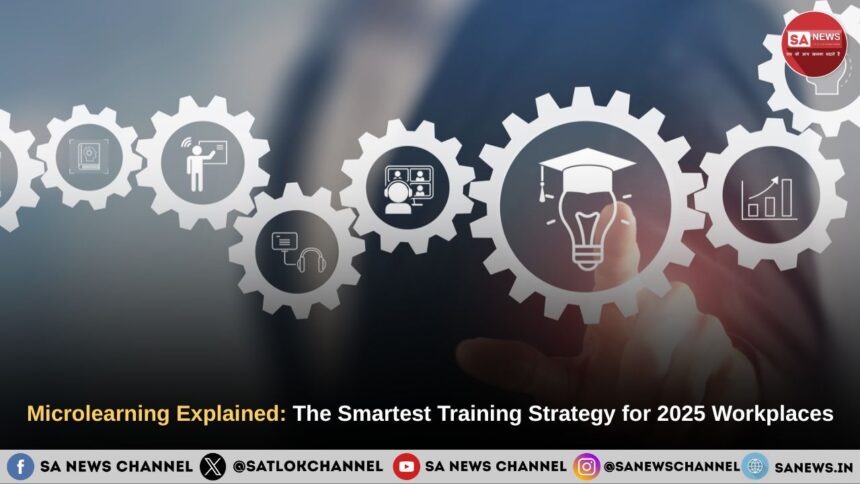In today’s fast-paced world, traditional training methods can feel outdated – long sessions, dense material, and disengaged employees. Enter microlearning, the revolutionary approach transforming workforce training in 2026.
- What is Microlearning?
- Why Microlearning Fits Modern Workplaces
- Benefits of Microlearning for Employees and Organizations
- How to Implement Microlearning in Your Organization
- 1. Identify Goals:
- 2. Select Engaging Formats:
- 3. Leverage Technology:
- 4. Track Progress:
- 5. Iterate and Improve:
- Challenges and How to Overcome Them
- News & Industry Insights (2026)
- Drawing Wisdom from Spirituality for Lifelong Learning
- FAQs on Microlearning
Imagine delivering powerful lessons in just 5–10 minutes – short enough to fit into any schedule, yet impactful enough to boost performance and retention. Microlearning breaks complex topics into bite-sized, engaging modules that employees can easily absorb and apply.
Whether it’s a 5-minute video on customer service or a quick cybersecurity quiz, this method prioritizes efficiency, flexibility, and engagement. With the rise of remote work and the growing need for continuous upskilling, microlearning has become more relevant than ever.
In this blog, we’ll explore how microlearning works, its benefits, real-world examples, and practical steps to implement it effectively. Ready to revolutionize your training strategy? Let’s dive into the future of learning!
What is Microlearning?
Microlearning is a modern training method that delivers content in short, focused bursts typically 5 to 10 minutes long. These bite-sized modules may include videos, quizzes, infographics, or interactive scenarios tailored to specific learning goals.
Unlike traditional training sessions that last for hours, microlearning is designed to be quick, engaging, and easy to digest. It’s ideal for today’s workforce, where attention spans are shorter and employees juggle multiple responsibilities.
By breaking down complex topics into manageable chunks, microlearning helps learners stay focused, retain knowledge longer, and apply new concepts effectively.
Why Microlearning Fits Modern Workplaces
The modern workplace is changing rapidly – from remote setups to hybrid models and constant technological innovation. Microlearning aligns perfectly with this evolution because it is:
Time-Efficient: Employees can learn during short breaks, commutes, or between meetings.
Highly Engaging: Interactive formats like gamified quizzes, short videos, or infographics keep learners motivated.
Improves Retention: According to the Journal of Applied Psychology (2023), spaced, short lessons improve retention by up to 20% compared to traditional methods.
Cost-Effective: Organizations save significantly on training expenses while achieving better outcomes.
Also Read: Learning New Languages and the Role of Digital Tools
Microlearning empowers both employers and employees by delivering effective, measurable results with minimal time investment.
Benefits of Microlearning for Employees and Organizations
Microlearning isn’t just convenient-it’s transformative. Here’s how it benefits both sides:
Flexibility: Employees can access training anytime, anywhere, especially via mobile devices.
Personalization: Content can be customized for specific roles, departments, or skill levels.
Scalability: Easy to deploy and update across teams or even global workforces.
Boosts Productivity: Short lessons reduce downtime and enable employees to apply skills faster.
Encourages Lifelong Learning: Fosters a culture of continuous growth and adaptability.
Example: A retail company might use a 5-minute video to train staff on handling customer complaints, while a tech firm could deploy daily quizzes to reinforce cybersecurity best practices. These small steps consistently lead to major performance gains.
How to Implement Microlearning in Your Organization
Implementing microlearning effectively requires thoughtful planning. Here’s a simple roadmap:
1. Identify Goals:
Define the exact skills or gaps to address (e.g., leadership, compliance, technical training).
2. Select Engaging Formats:
Use videos, podcasts, quizzes, or interactive apps to hold attention.
3. Leverage Technology:
Platforms like LinkedIn Learning, Coursera for Teams, or custom LMS tools can streamline delivery.
4. Track Progress:
Use analytics to monitor engagement, completion rates, and retention.
5. Iterate and Improve:
Collect feedback and continuously refine the learning experience.
Challenges and How to Overcome Them
While microlearning offers major advantages, it also has challenges – such as content creation demands or resistance to new methods. To overcome these:
Educate Teams: Clearly communicate the benefits and flexibility of microlearning.
Invest in Quality Content: Use e-learning tools like Articulate 360 or hire instructional designers.
Ensure Consistency: Maintain regular microlearning sessions to keep learning momentum strong.
With proper planning and engagement, even skeptical employees soon realize its benefits.
News & Industry Insights (2026)
According to a 2026 Deloitte report, 74% of organizations that adopted microlearning observed a 25% boost in employee engagement and productivity.
Additionally, a 2024 eLearning Industry study revealed that microlearning reduces training time by 50% while improving retention by 20%.
Leading global firms such as Google and IBM have integrated microlearning into their workforce strategies to upskill employees efficiently and cost-effectively.
(Sources: Deloitte Insights 2026, eLearning Industry 2024)
Drawing Wisdom from Spirituality for Lifelong Learning
The teachings of Sant Rampal Ji Maharaj emphasize that true progress arises from consistent, focused efforts toward meaningful growth. He says,
“Kabir, dheere dheere re mana, Dheere sab kuch hoye,
Mali siche sau ghada, Ritu aaye phal hoye.”
In 2026, as workplaces evolve with technology and rapid change, microlearning emerges as a tool to make learning meaningful and manageable. The same principle echoes in the teachings of Sant Rampal Ji Maharaj, who explains that true knowledge should bring inner transformation, not just external success. His message emphasizes learning with purpose and compassion—values that every organization can integrate through thoughtful training practices. Just as Sant Rampal Ji Maharaj’s initiatives like the Annapurna Muhim nourish society through selfless service, microlearning nourishes the intellect by fostering curiosity and consistency.
Together, they show that growth—spiritual or professional—comes from humility, daily effort, and a desire to benefit others. By following this balanced approach, organizations can build not only skilled employees but also empathetic, value-driven human beings.
FAQs on Microlearning
1. What is microlearning, and how does it work?
Microlearning delivers short, focused modules (5–10 minutes) like videos or quizzes to teach specific skills efficiently.
2. How is microlearning different from traditional training?
Traditional training involves lengthy workshops, while microlearning offers quick, engaging lessons that fit into daily routines.
3. Can microlearning be used for all types of training?
Yes. It’s ideal for technical, soft skills, compliance, and leadership training – adaptable for any goal.
4. What tools are best for microlearning?
Platforms like LinkedIn Learning, Articulate 360, and custom LMS systems are great for content delivery.
5. How do I measure the success of microlearning?
Track metrics like completion rates, quiz results, and employee feedback; assess productivity improvements.
6. Is microlearning expensive to implement?
No. It’s highly cost-effective, reducing training time and utilizing digital tools that save traditional costs.









